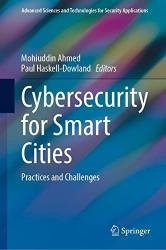 Название: Cybersecurity for Smart Cities: Practices and Challenges
Название: Cybersecurity for Smart Cities: Practices and ChallengesАвтор: Mohiuddin Ahmed, Paul Haskell-Dowland
Издательство: Springer
Год: 2023
Страниц: 210
Язык: английский
Формат: pdf (true), epub
Размер: 14.5 MB
Ensuring cybersecurity for smart cities is crucial for a sustainable cyber ecosystem. Given the undeniable complexity of smart cities, fundamental issues such as device configurations and software updates should be addressed when it is most needed to fight cyber-crime and ensure data privacy.
This book addresses the cybersecurity challenges associated with smart cities, aiming to provide a bigger picture of the concepts, intelligent techniques, practices and research directions in this area. Furthermore, this book serves as a single source of reference for acquiring knowledge on the technology, processes and people involved in the next-generation of cyber-smart cities.
Internet of Things (IoT) is defined as a network of connected physical objects with sensors and ability of processing data with several other technological devices in order to be able to connect and exchange data within each other. Any particular thing or electrical device that has the capability to get connected to the internet and exchange data as a part of information comes under the umbrella of IoT. Several traditionally common but new disruption of IoT includes, Smart home, Smart healthcare system, automotive waste management system, mobile pharmacy, smart fire alarms, smart traffic management, smart security system, and smart city etc. Amongst all these, smart city is the updated version of a casual urban life which enables all the connected devices to share and transfer data within each other easing the as usual pattern of an individual's life in a city. In order to meet the social needs of a city, it is important and also required to implement a technologically advanced solution for the city by introducing Information and Communication Technologies (ICT) with an amalgamation of IoT. IoT tends to contribute as a strategy to take an attempt to bring immense changes in a basic lifestyle of the residents. A smart city is absolutely dependent on the big data collected from the smart components around the city. It is made up of several IoT sensors, engines and people with the motive to provide an efficient operation of the daily tasks. ICTs are directly utilized as a means for enhancing performance, consistency and interactions of the connected components of the city which eventually improves the communication between the connected nodes and reduces the overall cost by consumption of resources where and when needed. The prime highlight of the philosophy of a smart city is to escalate the standards as well as establishing efficient and more reliable technological solutions within the diverse network services of the metropolitan arena. IoT is assumed to be the chief model in order to make an intelligent city as its ability to fabricate smart appliances within the city enables the communities to be quick on the uptake. One of the prominent and vital components of an IoT application such as a smart city, is the sensor which interconnects the related objects across the network so as to share the information and deliver vital services within the residents of a smart city. Though IoT is a combination of sensors, electronic devices and other relevant softwares to control and monitor the overall performance and efficacy of the other related parts of a system, there is still a higher risk of facing a challenge for any IoT driven company to constantly being able to generate these data.
Скачать Cybersecurity for Smart Cities: Practices and Challenges